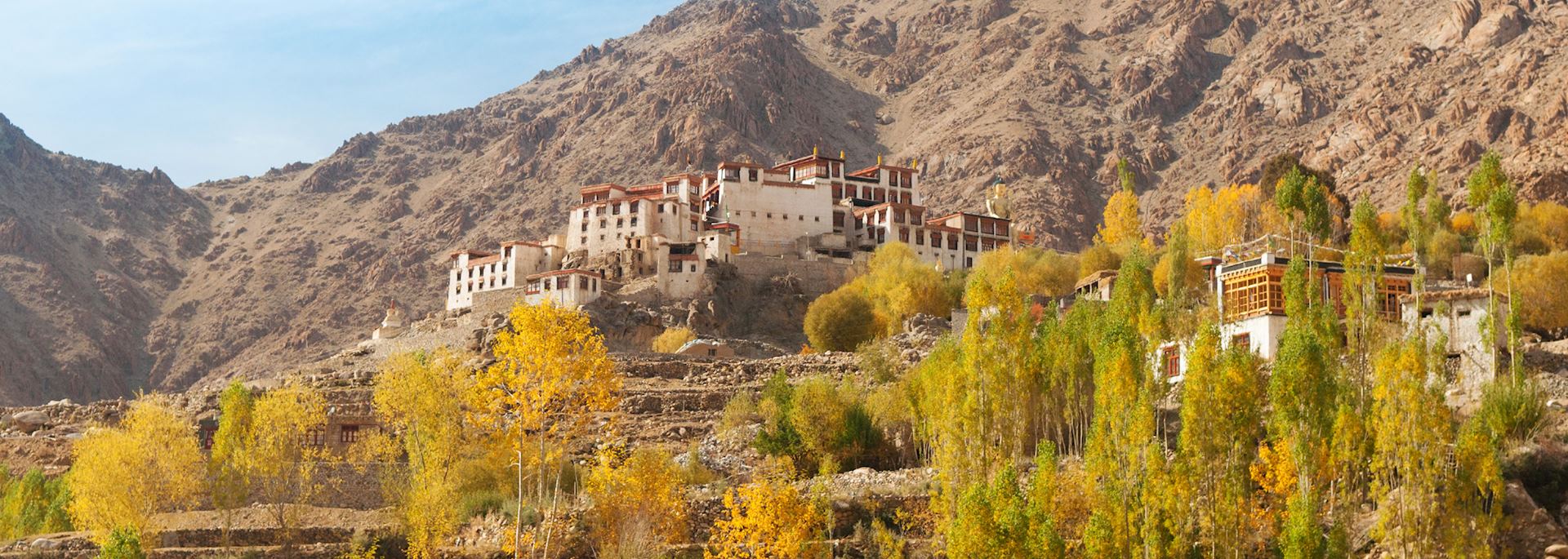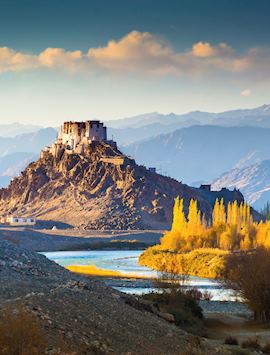By India specialist James
Hemmed in by the Great Himalaya to the south and the Kashmiri mountains to the north, the remote kingdom of Ladakh often feels worlds away from the rest of India — and none more so than in summer. While the rest of the country sees monsoon rains and high temperatures, Ladakh enjoys more comfortable temperatures and dazzling blue skies. Visit at any other time of year and you’ll find it snowbound.
For me, there are two main reasons to visit Ladakh. One: the scenery. In 1838, British explorer John Wood described Ladakh as, ‘the roof of the world’, and the label has rightly stuck. Two: the culture. Tibetan and Indian Buddhist sects have vied for prominence here since the 9th century, engendering a merging of beliefs, peoples and wealthy monasteries that you won’t find elsewhere in India.
Getting to Ladakh
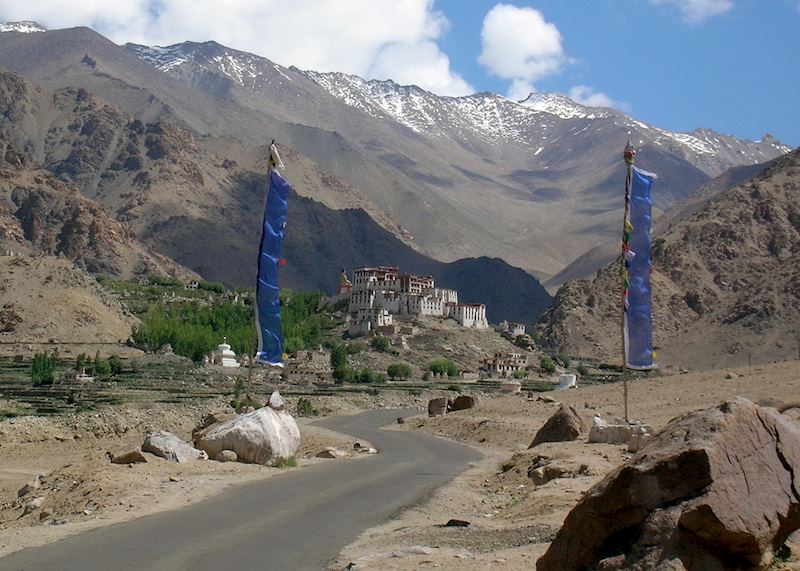
When Ladakh was an autonomous kingdom, Leh was its capital, and the city’s still the region’s focal point. Leh has a domestic airport so it’s best to take an international flight into Delhi then catch an onward flight to Leh. I suggest staying a night in Delhi in-between flights to avoid a long wait at the airport.
How to travel around Ladakh
You’re met at the airport by your guide and driver, who stay with you throughout the trip and offer the flexibility to explore at your own pace. The drivers are chosen for their motoring skills not their spoken English, but your guide can translate.
Due to the limited number of roads that cross the mountain passes, it’s difficult to create a circular route around the region. All roads spider-web out from Leh, so start here and drive out for short stays in the surrounding areas. As you revisit Leh a few times, I recommend splitting your exploration of the city over the multiple stays to avoid any one-night stops.
Spending a lot of time in the car can be a chore, but in Ladakh it’s part of the experience. The smooth and sweeping roads would make a Top Gear presenter screech with delight and I never tire of the mountainous gorges and valleys. There are plenty of places to stop off to explore as you drive: on a solitary trip I helped cook lunch at a Sikh temple, visited an Indian Army museum and photographed the confluence of the Zanskar and Indus rivers.
Leh

While the rest of India has embraced concrete housing with aplomb, in Leh you’ll find mud-brick homes and whitewashed monasteries. Its surroundings are a sweep of brilliant-green farmland and a thick line of ocher desert that blends upward to snow-topped mountains.
You need time to adjust to the altitude of 3,500 m (11,482 ft) above sea level (your specialist can help you factor this into your itinerary).
Much of Leh’s charm rests in its medieval old town, which once welcomed heavily laden trading caravans. Within the maze of narrow alleys you’ll come across mini chorten (Buddhist monuments) for daily worship and mani stones (prayer stones inscribed with mantras).
Near the entrance to the old town, the main bazaar trades a mix of household objects and trinkets. Most Ladakhis are near self-sufficient, so you won’t find much fresh produce on sale.
Looming high above the city are the inward-leaning walls of Leh Palace, which resembles Potala Palace in Lhasa, Tibet (though it predates by around 50 years). It’s open from sunrise to sunset each day (although the exact rooms on show can vary). Of the nine floors, the top two levels were the private apartments of the royal family, which remain off-limits.
Made from mud, brick and wood, this is no Mughal emperor’s palace, although the sheer scale and precarious mountain-top location are impressive. Stepping out onto the open terraces, you can see the smooth mur-kalak (mud and sand mix) walls up close. But, to appreciate the palace’s architectural might, it’s best viewed from Shanti Stupa, which perches to the west of the city.
Monasteries of the Indus Valley
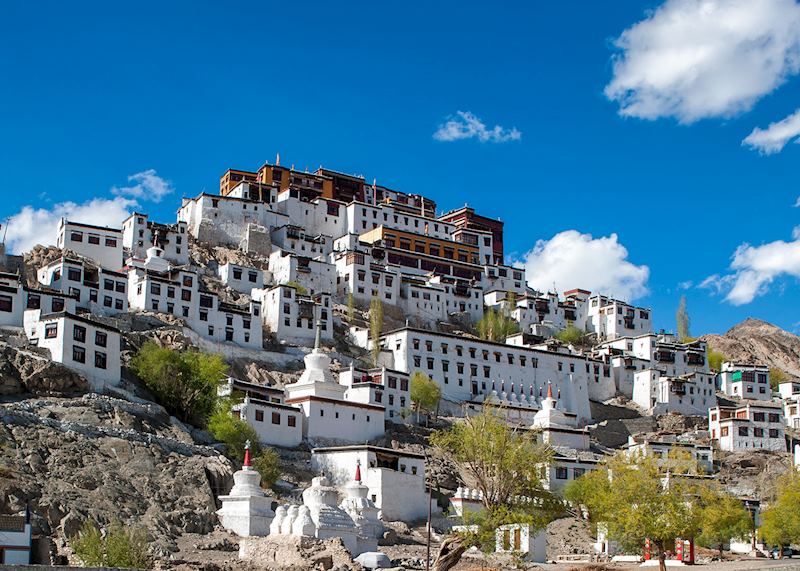
Still active places of worship, Ladakh’s monasteries lie along the Indus River. Five sects of Buddhism are represented here, each monastery with its own quirks. You could spend days touring them all, but I’d pick out the most interesting as Stakna, Hemis and Thikse. Conveniently grouped together, they can be visited in one day from Leh.
Thikse Monastery
One of the largest monasteries in Ladakh, Thikse sits atop a hill 30 minutes’ drive from Leh, amid green fields of buckwheat and millet. The 12 flat-topped stories line the sides of the outcrop like a giant staircase, with the most sacred rooms at the top. Unusually, monks of both sexes can live here, although it’s worth noting that a few sections can’t be accessed by women.
Thikse belongs to the reformist Gelugpa sect, led by the Dalai Lama. The current incumbent consecrated a modern Maitreya (‘the laughing Buddha’) temple that was built inside the monastery walls.
The monastery is very open and you’re generally free to wander where you wish. My guide was a former Buddhist monk — it’s common for Ladakhis to spend a period of their life in a monastery — and took me into the depths of the complex to meet some of the present inhabitants. If you make it to the monastery for 6am, you can listen to the monks chanting their morning prayers.

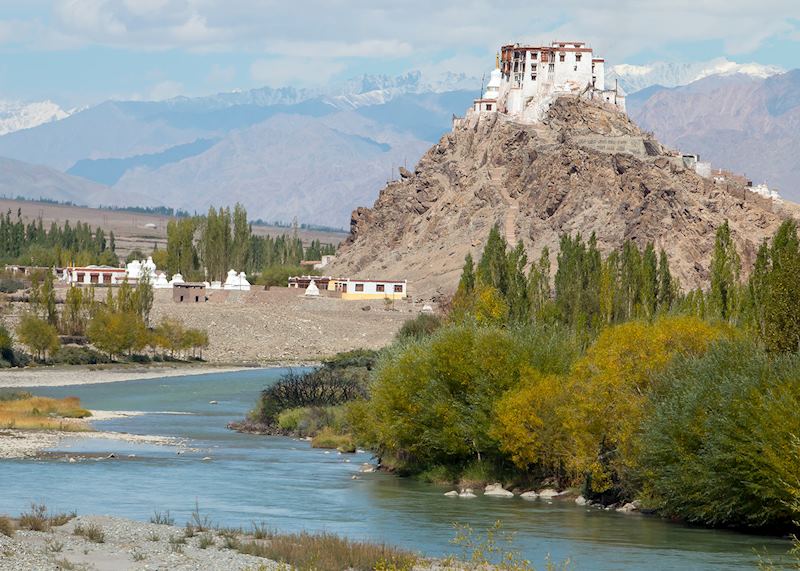
Hemis Monastery
Tucked away in a valley an hour’s drive from Leh, Hemis stayed undiscovered while the rest of the region was ransacked by raiding Mughal forces in the late 17th century. Consequently, it’s now the wealthiest monastery in Ladakh, with silver chorten and gold-leaf murals, and defended by gold guardian deity statues. The extensive museum contains a cache of precious religious regalia (including a large collection of stuffed animals).
Stakna Monastery
While Hemis houses more than 1,000 monks, Stakna has just 30. Its name means ‘tiger’s nose’, after the shape of the outcrop it crowns, which resembles a tiger’s face protruding from the plains. Climb to the monastery’s roof you have 360 degree views of the Karakoram Mountain Range, the inky-blue Indis River curving through the landscape below.
Where to stay in Leh
With few choices, there’s little debate required on places to stay in Leh: I suggest the Grand Dragon. It’s a clean, comfortable and well-located hotel that has managed to add traditional Ladakhi touches to a modern building.
Alchi
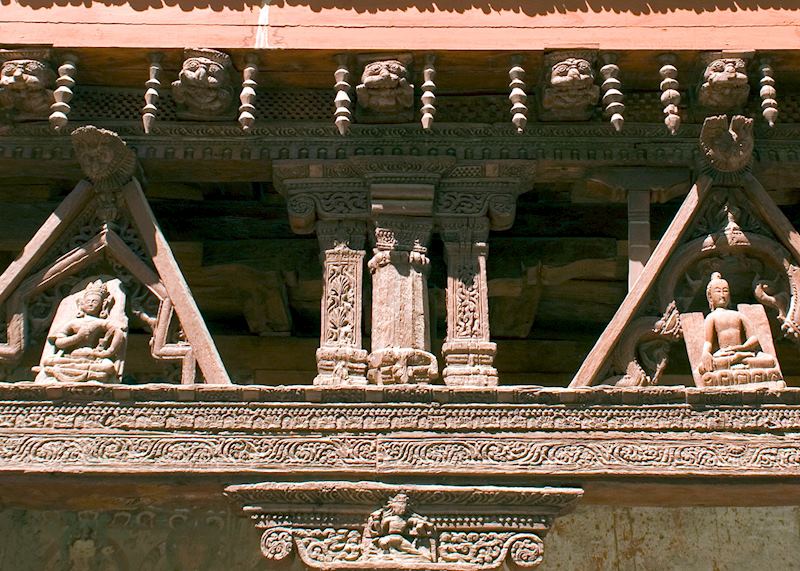
Just past the roar of Nimoo Bazgo Hydroelectric Plant, the monastery at Alchi has sat on flat land carved by the Indus River since the 11th century. A small village of mud-and-thatch houses has gradually grown around it. It’s a two-hour drive from Leh, and I suggest allowing a few nights here to explore (and at 3,120 m (10,236 ft), you’ll need to take things slowly).
Considered a quiet backwater, Alchi avoided the 16th-century Mughal raids, fortuitous as the monastery and temple complex contain some of the rarest and most exquisite examples of Buddhist art in India. The monastery is an enigma for archaeologists and theologists alike, as the artwork appears to have Persian influences. The murals, scattered across the site, depict monasteries that have never been discovered and the complex faces south (southeast is the norm).
There are five temples in the monastery, each filled with elaborate wood carvings and statues standing to attention on gilded plinths. The murals are so detailed you need to get up really close to see the finer brushwork. At other monasteries, I’d been treated to a confident and detailed analysis of the murals and relics on show. Here, my guide took a more scholarly approach, as there are so many unknowns. The Green Tara, a minor and rarely referenced goddess, appears in five prominent murals and no-one is quite sure why.
Alchi’s market, a short walk away, sells an array of locally made woven and knitted textiles, statues and Buddhist iconography. I opted for a brightly painted mask with a gaping mouth and questioning eyebrows. Used in chams (dances that tell of the triumph of good over evil), they’re said to stop any malice entering your property (though my wife decided mine would look better at work).
Where to visit from Alchi
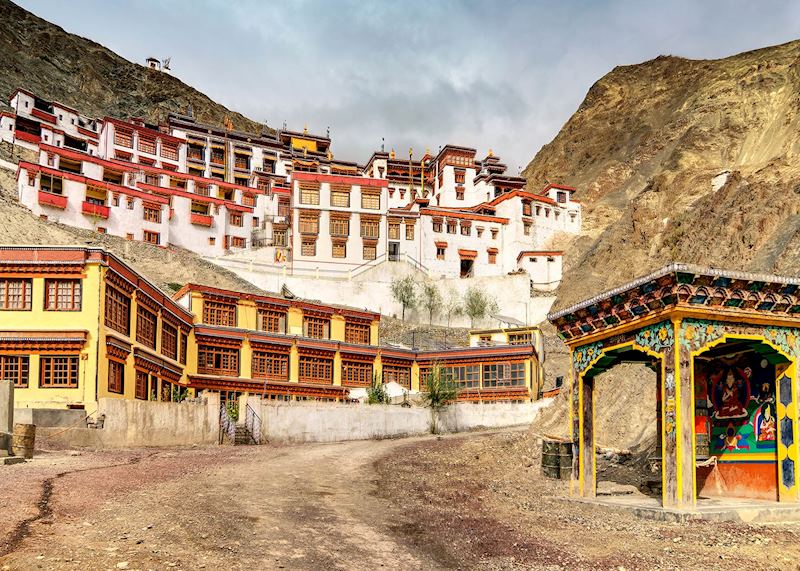
I spotted the whitewashed buildings of Rizong Monastery, bright against the surrounding rock, well before we arrived. An hour’s drive from Alchi, it presents an opportunity, my guide informed me, to see Buddhism in its purest form.
The monks here follow an austere regime. They’re not allowed bedding or heating in their cells, or any personal possessions, and can only leave the monastery if sick. And, they can’t touch anything that has been handled by a woman.
Due to their pious routine, the monks are likely to be chanting whenever you visit. The monastery itself has some vibrant murals and a collection of stupas, which bloom from the landscape like mushrooms.
Where to stay in Alchi
One of the oldest running hotels in Ladakh, Ule Ethnic Resort is a collection of cottages and huts on the banks of the Indus River. Responsibly minded, most of the hotel’s food is grown in its organic vegetable garden and electricity comes from its own mini hydroelectric plant.
The Nubra Valley
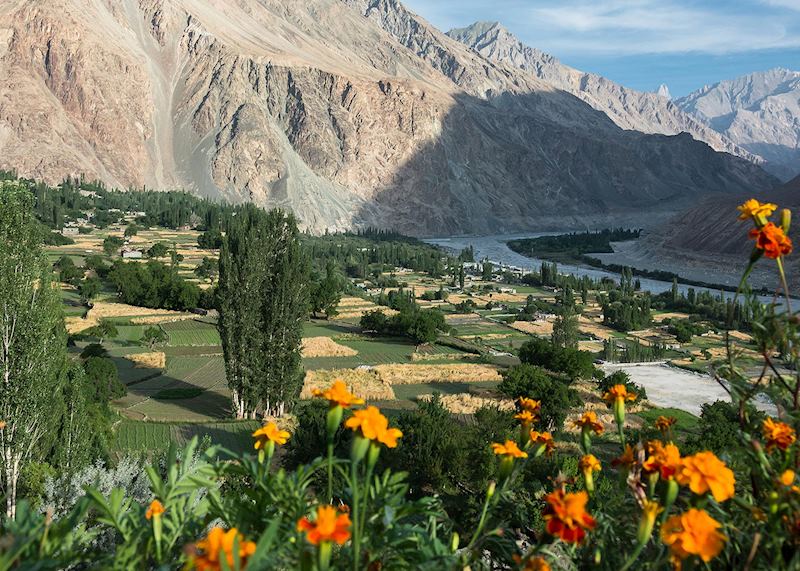
For me, the best part about the Nubra Valley is the journey there. Look north from Leh to the highest mountains on the skyline: it’s here you’re heading, and the mountains beyond only get bigger. The drive from Leh usually takes about five hours and crosses the world’s highest motorable pass, the Khardung La, at 5,380 m (17,650 ft).
As you drive up the pass, the Siachen Glacier stretches alongside the road (between September and June, the glacier covers the pass completely and renders it impassable). There’s a stopping place from where you can walk up the glacier to its highest point, marked by a small stupa and lines of prayer flags. Well above the snowline, the surrounding mountainsides are masked in white.
Driving down into the valley, which is cut off during winter, tiny villages begin to line the roadside. Apple, apricot and cherry trees were in bloom when I last visited, and the valley floor beyond was a bright lime green. At sunset the light continues to reflect off the mountains, illuminating the sheer walls against the inky black sky.
The landscape is scored with trails, many of which trace ancient trading routes that linked the Punjab to Central Asia. As well as a range of gentle walking routes, you can explore on a rare Bactrian (two-humped) camel. The best place to ride through are the silvery-gray sand dunes at Hunder, which seem lifted straight from a science-fiction novel.
Where to stay in the Nubra Valley
The Desert Himalaya is a camp of permanent white canvas tents, each en suite and furnished with chunky Lakadhi textiles. Opt for a luxury tent and you have your own terrace looking out toward the Karakoram Mountains. It’s worth noting that electricity and water supplies to the valley can be a little haphazard.
Luxury in Ladakh

If the idea of haphazard power supplies is off-putting, you can stay in Ladakh at a more luxurious level — although the added costs can be significant. The Ultimate Travelling Camp owns two camps in the region: Chamba Camp Diskit in the Nubra Valley, and Chamba Camp Thiksey just outside Leh.
Each offers a luxurious camping experience reminiscent of the Raj era. Your tent will have a four-poster bed, hand-crafted wooden furniture and a chandelier.
Start planning your trip to Ladakh
Start thinking about your experience. These itineraries are simply suggestions for how you could enjoy some of the same experiences as our specialists. They're just for inspiration, because your trip will be created around your particular tastes.
View All Tours in India